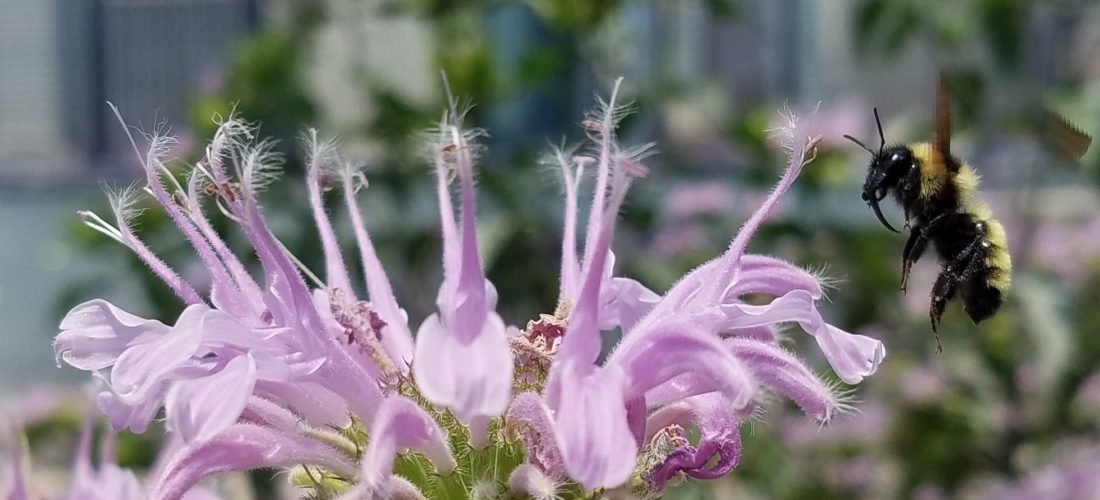 Golden Northern Bumble Bee on Bee Balm, photo by Pawel Pieluszynski
Golden Northern Bumble Bee on Bee Balm, photo by Pawel Pieluszynski
NYC Pollinator Resources includes information on wild pollinator species, plants to attract pollinators and books for additional reading curated by the NYCPWG
Helpful web sites
Pollinator Partnership – Pollinator Partnership’s mission is to promote the health of pollinators, critical to food and ecosystems, through conservation, education, and research.
Xerces.org – The Xerces Society for Invertebrate Conservation is an international nonprofit organization that protects the natural world through the conservation of invertebrates and their habitats.
Discoverlife.org – Their mission is to assemble and share knowledge in order to improve education, health, agriculture, economic development, and conservation throughout the world. They provide free on-line tools to identify species, teach and study nature’s wonders, report findings, build maps, process images, and contribute to and learn from a growing, interactive encyclopedia of life with 1,419,094 species pages and 820,236 maps.
Plants for Pollinators
Native Species Planting Guide for New York City (PDF, ## pp.) – Published by NYC Parks, this guide is a resource written to provide support for increasing biodiversity in our urban ecosystems.
Nwf.org/NativePlantFinder – Search by zip code to find plants that host the highest numbers of butterflies and moths to feed birds and other wildlife where you live.
Wildflower.org/plants – The Ladybird Johnson Wildflower Center plant database provides a full range of information useful to scientists, students, gardeners, native plant enthusiasts, landscape architects and others. It is the most comprehensive guide to North American native plants in existence, with a free and searchable database of information about more than 9,000 native plants, 50,000 plant images, answers to plant and natural gardening questions and more.
Suggested books
Caterpillars of Eastern North America, David L. Wagner (Princeton University Press, copyright 2005) – This lavishly illustrated guide will enable you to identify the caterpillars of nearly 700 butterflies and moths found east of the Mississippi. Full-page species accounts cover almost 400 species, with up to six images per species plus succinct text with information on distribution, seasonal activity, foodplants, and life history. These accounts are generously complemented with additional images of earlier instars, closely related species, noteworthy behaviors, and other intriguing aspects of caterpillar biology.
Pollinators of Native Plants, Heather Holm (Pollination Press LLC, 2014) – This comprehensive book illustrates the specific relationships between native pollinators and native plants. Organized by plant communities, the book profiles over 65 perennial native plants and the pollinators, beneficial insects and flower visitors the plants attract.
The Living Landscape, Rick Darke and Doug Tallamy (Timber Press, 2014) – You’ll learn the strategies for making and maintaining a diverse, layered landscape-one that offers beauty on many levels, provides outdoor rooms and turf areas for children and pets, incorporates fragrance and edible plants, and provides cover, shelter, and sustenance for wildlife. Richly illustrated and informed by both a keen eye for design and an understanding of how healthy ecologies work, The Living Landscape will enable you to create a garden that fulfills both human needs and the needs of wildlife communities.
Bringing Nature Home, Douglas Tallamy (Timber Press, 2007) – This book reveals the unbreakable link between native plant species and native wildlife-native insects cannot, or will not, eat alien plants. When native plants disappear, the insects disappear, impoverishing the food source for birds and other animals. However, everyone with access to a patch of earth can make a significant contribution toward sustaining biodiversity by simply choosing native plants. By acting on Douglas Tallamy’s practical and achievable recommendations, we can all make a difference.
Nature’s Best Hope, Douglas Tallamy (Timber Press, 2019) – Nature’s Best Hope shows how homeowners everywhere can turn their yards into conservation corridors that provide wildlife habitats. Because this approach relies on the initiatives of private individuals, it is immune from the whims of government policy. Even more important, it’s practical, effective, and easy-you will walk away with specific suggestions you can incorporate into your own green space.
A Guide to Native Plants of the New York City Region, Margaret Gargiullo (Rivergate Books, 2007) – This unique guide presents a detailed look at the full scope of flora that is native to this region and available for propagation. Geared specifically for landscape architects, designers, land managers, and restorationists, this book offers practical advice on how to increase the amount of indigenous flora growing in the metropolitan area, and in some cases, to reintroduce plants that have completely disappeared.